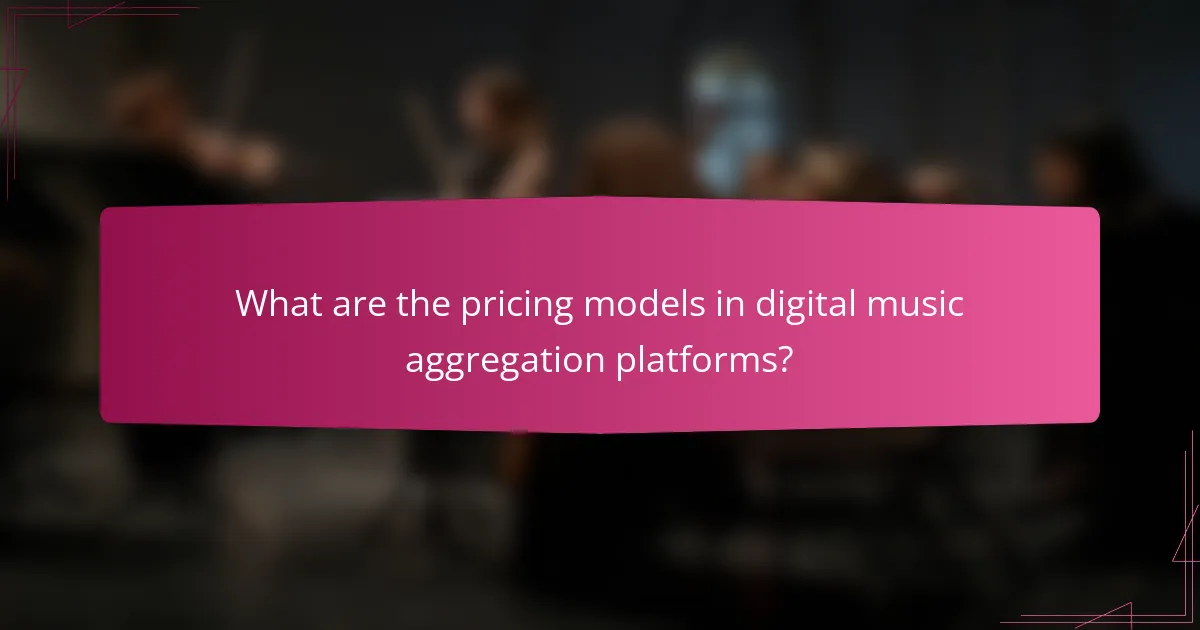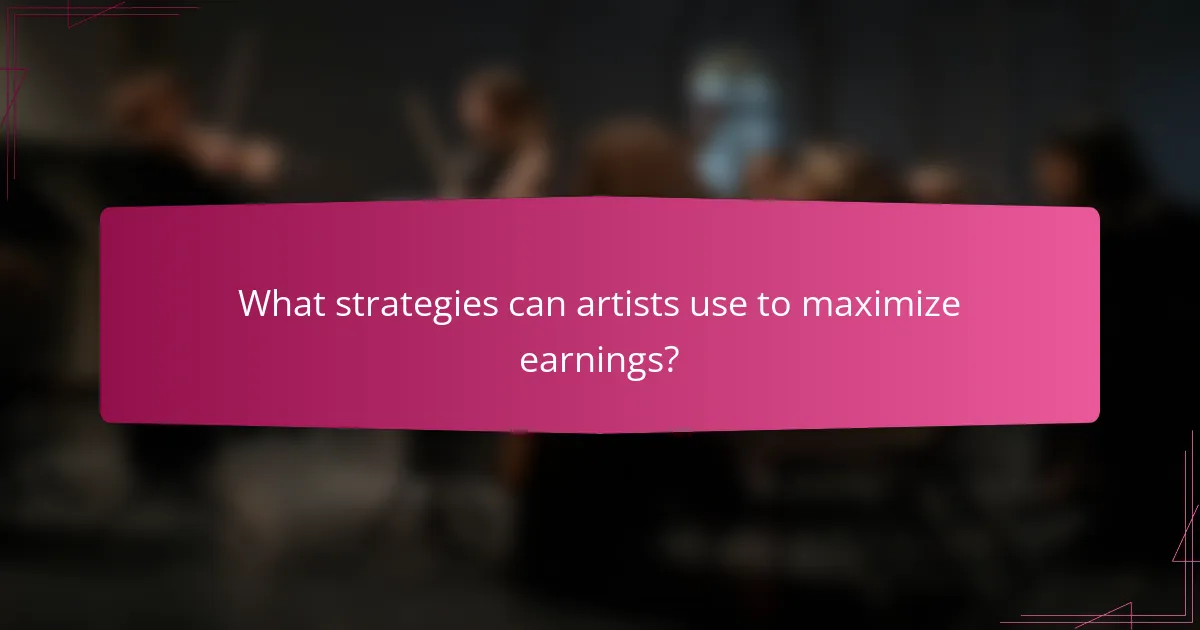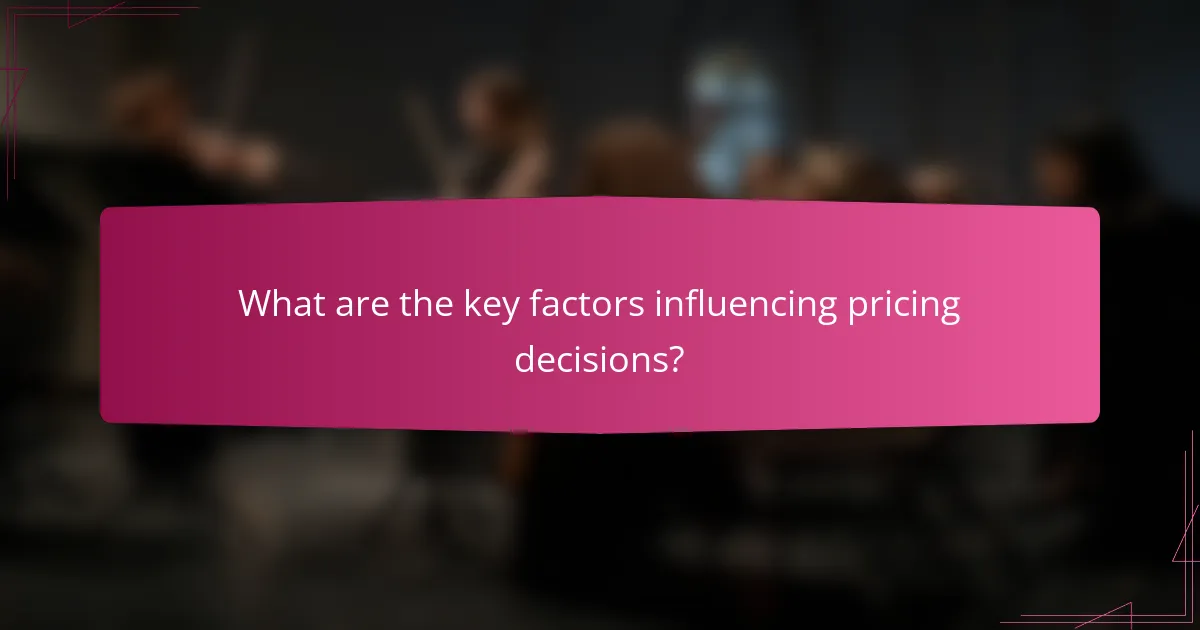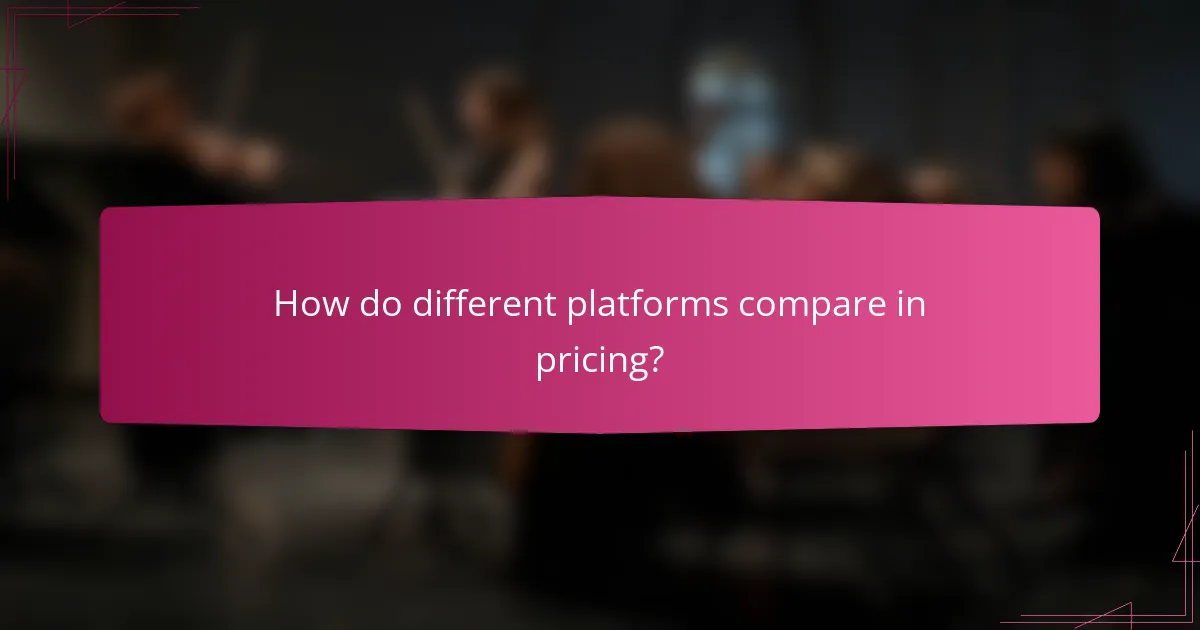Digital music aggregation platforms employ diverse pricing models that play a crucial role in shaping artist earnings and revenue distribution. These models, whether subscription-based or ad-supported, directly affect how much artists earn and influence their strategies for music promotion and distribution. By understanding these dynamics, artists can optimize their approaches to maximize visibility and revenue potential.

What are the pricing models in digital music aggregation platforms?
Digital music aggregation platforms utilize various pricing models to determine how artists earn revenue from their music. These models can significantly impact artist earnings and influence their distribution strategies.
Percentage-based revenue sharing
Percentage-based revenue sharing is a common model where the aggregator takes a percentage of the revenue generated from music sales or streams. Typically, this percentage can range from 10% to 30%, depending on the platform and the services provided.
Artists should carefully evaluate the terms of revenue sharing to understand how much they will retain from their earnings. It’s essential to consider additional factors such as marketing support and distribution reach when assessing the overall value of the service.
Flat fee subscription
A flat fee subscription model requires artists to pay a fixed amount, usually monthly or annually, for access to distribution services. This fee can vary widely, often ranging from around $10 to several hundred dollars per year, depending on the platform and features included.
This model can be beneficial for artists who release multiple tracks or albums, as they can keep all earnings without sharing a percentage. However, it’s crucial to ensure that the platform offers sufficient exposure and support to justify the subscription cost.
Tiered pricing structures
Tiered pricing structures offer different levels of service at varying price points, allowing artists to choose a plan that fits their needs. Each tier typically includes a different set of features, such as the number of releases, promotional tools, or analytics.
Artists should assess their career stage and distribution goals when selecting a tier. Starting with a lower tier can be a cost-effective way to test the platform before committing to a more expensive plan.
Pay-per-release fees
Pay-per-release fees charge artists a set amount for each individual release, which can be advantageous for those who release music infrequently. Fees can range from $5 to $50 per release, depending on the platform and additional services offered.
This model allows artists to avoid ongoing costs but may become expensive for those with a more active release schedule. Artists should calculate their expected release frequency to determine if this model is financially viable.
Freemium models
Freemium models provide basic distribution services for free, with the option to upgrade to premium features for a fee. This approach can attract new artists who are hesitant to invest upfront.
While the free version may limit certain functionalities, such as promotional tools or analytics, it allows artists to test the platform’s effectiveness. Artists should weigh the benefits of upgrading against their specific needs and goals for music distribution.

How do pricing models impact artist earnings?
Pricing models significantly influence artist earnings by determining how revenue is shared between platforms and creators. Different models, such as subscription-based or ad-supported, can lead to varying income levels for artists based on user engagement and distribution strategies.
Revenue distribution variations
Revenue distribution among digital music aggregation platforms can vary widely. For instance, platforms may take a percentage of the revenue generated, often ranging from 15% to 30%, which directly affects the amount artists receive. Understanding these variations is crucial for artists to choose the right platform that aligns with their financial goals.
Additionally, some platforms offer tiered models where higher engagement leads to better revenue shares. Artists should evaluate these options to maximize their earnings.
Impact of streaming volume
Streaming volume plays a critical role in determining artist earnings. Generally, the more streams a song receives, the higher the potential payout, but the actual earnings per stream can be quite low, often just a fraction of a cent. This means that artists need to focus on building a strong listener base to achieve significant revenue.
Artists can leverage social media and marketing strategies to increase their streaming volume, which can lead to better earnings over time. Consistent engagement with fans can drive more streams and, consequently, higher payouts.
Effect of promotional strategies
Promotional strategies can greatly affect artist earnings by increasing visibility and engagement. For example, utilizing targeted ads or collaborating with influencers can enhance an artist’s reach, leading to more streams and higher revenue. Artists should consider investing in marketing efforts that resonate with their target audience.
Moreover, platforms often provide promotional tools that can help artists gain traction. However, it’s essential to balance promotional spending with expected returns to avoid overspending without achieving desired results.

What strategies can artists use to maximize earnings?
Artists can maximize their earnings by effectively promoting their music, diversifying their distribution channels, and actively engaging with their fan base. Implementing these strategies can lead to increased visibility and revenue opportunities.
Leveraging social media for promotion
Social media platforms are essential tools for artists to promote their music and connect with fans. By sharing content such as behind-the-scenes footage, music snippets, and live performances, artists can build a loyal following and drive traffic to their music on streaming platforms.
Utilizing targeted advertising on platforms like Facebook and Instagram can further enhance reach. Artists should consider allocating a budget for ads to promote new releases or upcoming shows, which can significantly boost engagement and sales.
Utilizing multiple platforms
Distributing music across various digital platforms increases the chances of reaching different audiences. Artists should consider using popular services like Spotify, Apple Music, and Bandcamp, as well as niche platforms that cater to specific genres or demographics.
Each platform has its own audience and revenue model, so artists should analyze which platforms yield the best returns. For instance, Bandcamp allows artists to set their own prices, potentially leading to higher earnings per sale compared to streaming services that pay per stream.
Engaging with fan communities
Building and engaging with fan communities can create a strong support network for artists. This can be achieved through platforms like Patreon, where fans can subscribe for exclusive content, or through dedicated forums and social media groups.
Artists should actively participate in discussions, respond to fan inquiries, and offer unique experiences, such as virtual meet-and-greets. This not only fosters loyalty but can also lead to increased merchandise sales and concert ticket purchases.

What are the key factors influencing pricing decisions?
Pricing decisions in digital music aggregation platforms are primarily influenced by market demand, competitor pricing strategies, and the negotiation power of artists. Understanding these factors helps platforms optimize their pricing models to maximize revenue and artist earnings.
Market demand analysis
Market demand analysis involves assessing the popularity of music genres, trends in listener behavior, and overall consumption patterns. Platforms must evaluate how demand fluctuates with seasonal events, new releases, or emerging artists, as these factors can significantly impact pricing.
For example, during holiday seasons or major music festivals, demand may spike, allowing platforms to adjust prices accordingly. Utilizing data analytics tools can help in forecasting demand and setting competitive prices that attract both listeners and artists.
Competitor pricing strategies
Understanding competitor pricing strategies is crucial for digital music platforms to remain competitive. Platforms should analyze how similar services price their offerings, including subscription models, pay-per-download, and advertising-supported options.
For instance, if a competitor offers a premium subscription at a lower rate, it may prompt a reevaluation of pricing structures. Regularly benchmarking against competitors can help platforms identify pricing sweet spots and potential areas for differentiation.
Artist negotiation power
Artist negotiation power plays a significant role in pricing decisions, particularly for high-profile musicians. Established artists often have the leverage to negotiate higher royalties or better terms, which can influence the overall pricing model of the platform.
Platforms should develop strategies to balance artist compensation with consumer pricing. Offering tiered pricing models or exclusive content can be effective ways to accommodate high-demand artists while maintaining profitability.

How do different platforms compare in pricing?
Digital music aggregation platforms vary significantly in their pricing structures, impacting artist earnings and revenue strategies. Understanding these differences is crucial for artists and labels to maximize their income and choose the right platform for distribution.
Subscription-based models
Subscription-based models charge users a monthly fee for access to a vast library of music. Platforms like Spotify and Apple Music typically offer tiered pricing, allowing users to choose between individual, family, or student plans. This model generates steady revenue for artists based on the number of streams their music receives.
Artists should consider that while subscription services provide consistent payouts, the per-stream rate can be low, often ranging from a fraction of a cent to a few cents. Therefore, building a large listener base is essential for maximizing earnings.
Pay-per-download models
Pay-per-download models allow users to purchase individual tracks or albums, providing a one-time payment to artists. Platforms such as iTunes and Bandcamp operate on this model, enabling artists to set their own prices. This approach can lead to higher earnings per sale compared to streaming services.
However, artists must actively promote their music to drive sales, as revenue is directly tied to the number of downloads. Pricing strategies should consider factors like genre popularity and competition to optimize sales.
Freemium models
Freemium models offer users free access to music with the option to upgrade to a premium subscription for additional features. Services like SoundCloud and YouTube Music utilize this approach, generating revenue through ads and premium subscriptions. Artists can benefit from exposure through free access while earning from ads and premium upgrades.
It’s important for artists to engage with their audience and encourage upgrades to premium services, as ad revenue can be unpredictable. Balancing free content with exclusive premium offerings can enhance overall earnings.
Revenue share agreements
Revenue share agreements dictate how much of the income generated from music sales or streams goes to the artist versus the platform. Most digital music platforms retain a percentage of the revenue, which can range from 15% to 30% or more. Understanding these agreements is vital for artists to gauge their potential earnings.
Artists should carefully review the terms of revenue share agreements before signing up with a platform. Negotiating better terms or exploring multiple platforms can significantly impact overall earnings.
